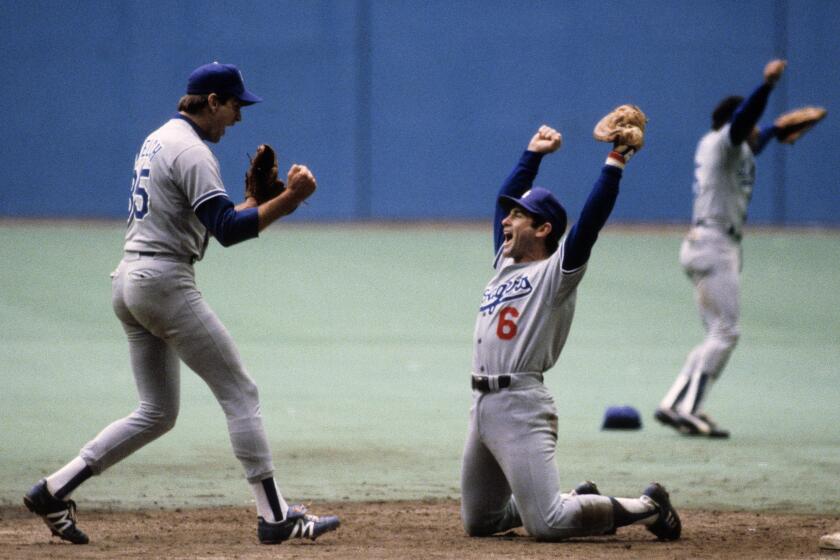Are they still relevant? Everyone’s a critic.
I was pondering the sad plight of critics in America the other day when I saw a review in our Calendar section of two new baseball video games. Knowing this was a subject of great interest to my 9-year-old son -- and always eager to demonstrate to him how relevant our newspaper is to his life -- I showed him the review. Its conclusions were clear: One of the games, MLB 2K8, was a dog, so poorly designed and hard to play that our reviewer dubbed it “the Devil Rays of video games,” after the perennial last place team from the AL East.
So guess which game my son wants for his birthday?
When I asked him why he wasn’t put off by our critic’s D grade for the game, my son explained: “My friend Jimmy has it and he really likes it. We played it once and it feels like real baseball, except you’re just using buttons to play.”
Whether you’re talking to a 9-year-old Little Leaguer, a 19-year-old college kid or a 29-year-old music fan, when you ask why he or she no longer relies on critics for entertainment choices, the answer boils down to the same thing: “I trust my friends more than I trust that guy writing the review.”
There was a time when critics were our arbiters of culture, the ultimate interpreters of intellectual discourse. When I was growing up, eager to write about the arts, it was just as important to read Pauline Kael, Frank Rich and Lester Bangs as it was to see a Robert Altman film, a David Mamet play or listen to the latest Elvis Costello album. Critics gave art its context, explained its meaning and guided us to new discoveries.
As a flood of stories in recent weeks has shown, those days are going, going, gone. Critics today are viewed as cultural dinosaurs on the verge of extinction. Most of the attention lately has focused on the demise of film critics. The Salt Lake Tribune’s Sean P. Means actually posted a list Wednesday of film critics, now totaling 28, who have lost or decided to leave their jobs in the last two years, including such notables as Newsweek’s David Ansen, the New York Daily News’ Jack Mathews and the Chicago Tribune’s Michael Wilmington.
Critics are being downsized all over the place, whether it’s in classical music, dance, theater or other areas in the arts. While economics are clearly at work here -- seeing their business model crumble, many newspapers simply have decided they can’t afford a full range of critics anymore -- it seems clear that we’re in an age with a very different approach to the role of criticism.
Obviously the Internet has played a big role in this shift. It has promoted a democratization of opinion in which solo bloggers -- most famously Matt Drudge -- can outstrip mammoth news organizations. Whenever I spend time with young students, I see an even more intriguing concept at work. Although they are heavily influenced by peer group reaction to films or music, they do listen to critics, but largely as a group, not as individual brands. The age of the singular critical voice is ending -- people prefer the wisdom of a community.
Having just spent an evening with students studying entertainment reporting at the USC School of Journalism, I asked them Friday for their take on critics. Nearly everyone said that when they want to read up on a film, they often go to metacritic.com or rottentomatoes.com, websites that offer a healthy sample of critical consensus. As student Victor Farfan put it: “They put all the reviews in one easy, convenient, conglomerated source that gives you a breadth of opinions from trusted sources and some less familiar ones.”
Other students acknowledge that they put little stock in critical opinion, lumping it in with the cascade of hype that accompanies today’s entertainment. “We tend to be wary of anything that seems over-hyped, whether it’s by critics or over-advertising,” said Courtney Lear. “Personally, I trust certain actors, artists or directors from previous experiences. The Arcade Fire is playing in Hollywood? Their last album rocked my socks off. When do tickets go on sale? They’ve already gained my trust.”
For a generation that lives on the Web, even the most eloquent critics are distant thunder, rarely promoted well on newspaper websites and often reluctant to use blogs as a platform to spread their gospel. Even among savvy journalism students, it’s hard to find anyone who knows any critics by name.
Of course, it’s not only the Web that is putting nails in the coffin. When it comes to film, no one has done a better job of robbing critics of credibility than the movie studios themselves, whose blurb ads are a thoroughly corrupt and cynical invention that has done more to devalue critics than any incursion from the Internet. The ads attempt to lull the filmgoer into briefly putting one thought into their head: “Maybe that piece of junk isn’t really that bad.”
Of course, once you see the movie and realize how awful it is, there’s a new thought in your head: “Once bitten, twice shy.” By turning us into cynics, studios have encouraged us to distrust critics. Unless you are willing to put in the time to rank dozens upon dozens of critics in your head (Wireless Magazines’ Earl Dittman [hack] vs. the New York Times’ A.O. Scott [smart guy]), most sensible filmgoers simply ignore the blurbs altogether.
There are, of course, still plenty of serious critics, but the studios do their best to prevent them from writing about their mainstream fare. At People magazine, for example, film critic Leah Rozen has a Monday deadline to get reviews into an issue that hits newsstands on Friday. Even though she works for a publication that would be ideal to promote the family-oriented “Nim’s Island,” which opened Friday, Rozen says that 20th Century Fox didn’t screen the film for People and other New York-based critics until noon Thursday.
“The studio knows what our deadlines are,” she said. “So I assume they knew if they screened it then, we wouldn’t be able to review it.”
To be fair, the media is also responsible for undermining its critics’ authority. Scores of TV’s film critics have become quote whores, willing to say anything (“Awesome!” Fox TV’s Shawn Edwards enthused about the woeful “Drillbit Taylor”) to get their names atop movie ads. The news weeklies often devalue their star critics by using them to deliver exclusive interviews with big-shot filmmakers, allowing the studios to create some much-needed aura-by-association for their summer blockbusters. At all too many newspapers, the emergence of various service-oriented sections has created a thumbs-up or -down mentality. As Rozen explains: “Editors everywhere have been affected by the influence of service journalism to the point where you find them asking why critics are going on at such length when all the readers really want to know is -- should they go to the movie or not?” Rozen says every time there’s a redesign at People, the pictures get bigger and the text hole gets smaller. “Put it this way,” she says, referring to one of the most critically heralded movies of last year. “I reviewed ‘Eastern Promises’ in two sentences.”
The flaws extend beyond film. In pop music, especially at top-of-the-food-chain publications like Rolling Stone, critics have a distressing tendency to pull their punches for leading artists. As Bill Wyman points out in a hilarious post at his Hitsville.com site, a long string of Rolling Stone critics has gotten twisted into pretzels to try to portray any new R.E.M. album as a throwback to the band’s glory days, even though the albums now written off as disappointments were the ones originally labeled comebacks.
“In the music industry press, you are frequently discouraged from writing negative reviews,” Wyman told me. “It’s considered uncool to say that a lot of pop music is terrible. You’re not supposed to tell readers things they don’t want to hear.”
The best critics have always done exactly the opposite. As the late critic Kingsley Amis put it: “If you can’t annoy somebody, there’s little point in writing.” Whether critics are irritants or masters of elucidation, opinions still matter. But no one is respected simply because of the authority of the institution they write for. The Web isn’t the enemy of critical thinking. The land of a million blogs is a medium brimming with opinion. What’s different is the reader gets to decide whose opinion matters the most. It’s a big adjustment, but maybe it’s time critics, like many artists, realize they should pay more attention to their audience.
--
“The Big Picture” runs every Tuesday in Calendar. E-mail questions or comment to patrick.goldstein@latimes.com.
More to Read
Go beyond the scoreboard
Get the latest on L.A.'s teams in the daily Sports Report newsletter.
You may occasionally receive promotional content from the Los Angeles Times.










